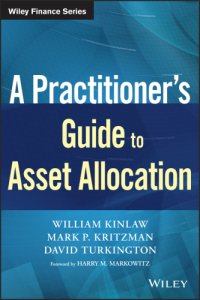
Ebook: A Practitioner's Guide to Asset Allocation
Author: Kinlaw William, Kritzman Mark P., Turkington David
- Tags: Asset allocation, BUSINESS & ECONOMICS--Finance, Portfolio management, Electronic books, BUSINESS & ECONOMICS -- Finance
- Series: Wiley finance series
- Year: 2017
- Publisher: John Wiley & Sons
- City: Hoboken;New Jersey
- Language: English
- epub
Cover -- Title Page -- Copyright -- Contents -- Foreword -- Preface -- Section One: Basics of Asset Allocation -- Chapter 1: What Is an Asset Class? -- Stable Aggregation -- Investable -- Internally Homogeneous -- Externally Heterogeneous -- Expected Utility -- Selection Skill -- Cost-Effective Access -- Potential Asset Classes -- References -- Notes -- Chapter 2: Fundamentals of Asset Allocation -- The Foundation: Portfolio Theory -- Practical Implementation -- References -- Notes -- Section Two: Fallacies of Asset Allocation -- Chapter 3: The Importance of Asset Allocation -- Fallacy: Asset Allocation Determines More Than 90 Percent of Performance -- The Determinants of Portfolio Performance -- The Behavioral Bias of Positive Economics -- The Samuelson Dictum -- References -- Notes -- Chapter 4: Time Diversification -- Fallacy: Time Diversifies Risk -- Samuelson's Bet -- Time, Volatility, and Probability of Loss -- Time and Expected Utility -- Within-Horizon Risk -- A Preference-Free Contradiction to Time Diversification -- The Bottom Line -- References -- Notes -- Chapter 5: Error Maximization -- Fallacy: Optimized Portfolios Are Hypersensitive to Input Errors -- The Intuitive Argument -- The Empirical Argument -- The Analytical Argument -- The Bottom Line -- References -- Notes -- Chapter 6: Factors -- Fallacy: Factors Offer Superior Diversification and Noise Reduction -- What Is a Factor? -- Equivalence of Asset Class and Factor Diversification -- Noise Reduction -- Where Does This Leave Us? -- References -- Notes -- Chapter 7: 1/N -- Fallacy: Equally Weighted Portfolios Are Superior to Optimized Portfolios -- The Case for 1/N -- Setting the Record Straight -- Empirical Evidence in Defense of Optimization -- Practical Problems with 1/N -- Broken Clock -- The Bottom Line -- References -- Note -- Section Three: Challenges to Asset Allocation.;Since the formalization of asset allocation in 1952 with the publication of Portfolio Selection by Harry Markowitz, there have been great strides made to enhance the application of this groundbreaking theory. However, progress has been uneven. It has been punctuated with instances of misleading research, which has contributed to the stubborn persistence of certain fallacies about asset allocation. A Practitioner's Guide to Asset Allocation fills a void in the literature by offering a hands-on resource that describes the many important innovations that address key challenges to asset allocation and dispels common fallacies about asset allocation. The authors cover the fundamentals of asset allocation, including a discussion of the attributes that qualify a group of securities as an asset class and a detailed description of the conventional application of mean-variance analysis to asset allocation. The authors review a number of common fallacies about asset allocation and dispel these misconceptions with logic or hard evidence. The fallacies debunked include such notions as: asset allocation determines more than 90% of investment performance; time diversifies risk; optimization is hypersensitive to estimation error; factors provide greater diversification than assets and are more effective at reducing noise; and that equally weighted portfolios perform more reliably out of sample than optimized portfolios. A Practitioner's Guide to Asset Allocation also explores the innovations that address key challenges to asset allocation and presents an alternative optimization procedure to address the idea that some investors have complex preferences and returns may not be elliptically distributed. Among the challenges highlighted, the authors explain how to overcome inefficiencies that result from constraints by expanding the optimization objective function to incorporate absolute and relative goals simultaneously. The text also explores the challenge of currency risk, describes how to use shadow assets and liabilities to unify liquidity with expected return and risk, and shows how to evaluate alternative asset mixes by assessing exposure to loss throughout the investment horizon based on regime-dependent risk. This practical text contains an illustrative example of asset allocation which is used to demonstrate the impact of the innovations described throughout the book. In addition, the book includes supplemental material that summarizes the key takeaways and includes information on relevant statistical and theoretical concepts, as well as a comprehensive glossary of terms.
Download the book A Practitioner's Guide to Asset Allocation for free or read online
Continue reading on any device:

Last viewed books
Related books
{related-news}
Comments (0)